Attracting & Retaining Workforce: HRM Challenges in Retail Sector
VerifiedAdded on 2023/06/11
|12
|3571
|263
Essay
AI Summary
This essay explores the challenges faced by modern organizations, particularly in the Australian retail sector, concerning workforce attraction and retention. It delves into five major themes of workforce planning: human resource management and strategic human resource management, employee turnover and retention, diversity management and work-life balance, performance management systems and evaluation, and motivation, rewards, and compensation. The analysis highlights issues such as employee dissatisfaction due to monetary factors, lack of growth opportunities, and unmet job expectations. The importance of diversity management in creating a valued workforce and the role of performance management systems in providing continuous feedback and recognition are also discussed. The essay emphasizes the need for retail organizations to address these challenges to improve employee retention, productivity, and overall organizational performance. Desklib offers a platform for students to access this and other solved assignments.
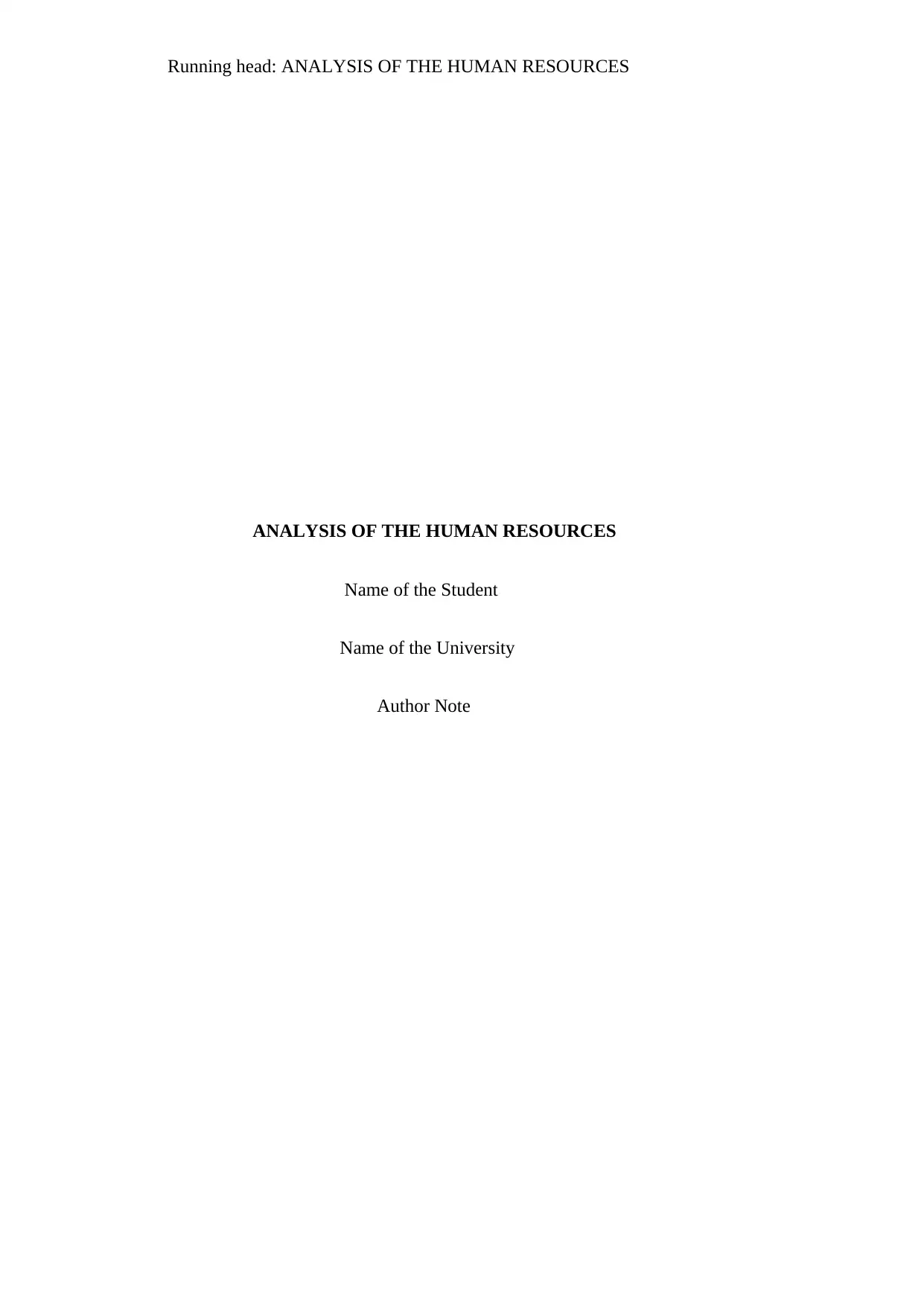
Running head: ANALYSIS OF THE HUMAN RESOURCES
ANALYSIS OF THE HUMAN RESOURCES
Name of the Student
Name of the University
Author Note
ANALYSIS OF THE HUMAN RESOURCES
Name of the Student
Name of the University
Author Note
Paraphrase This Document
Need a fresh take? Get an instant paraphrase of this document with our AI Paraphraser
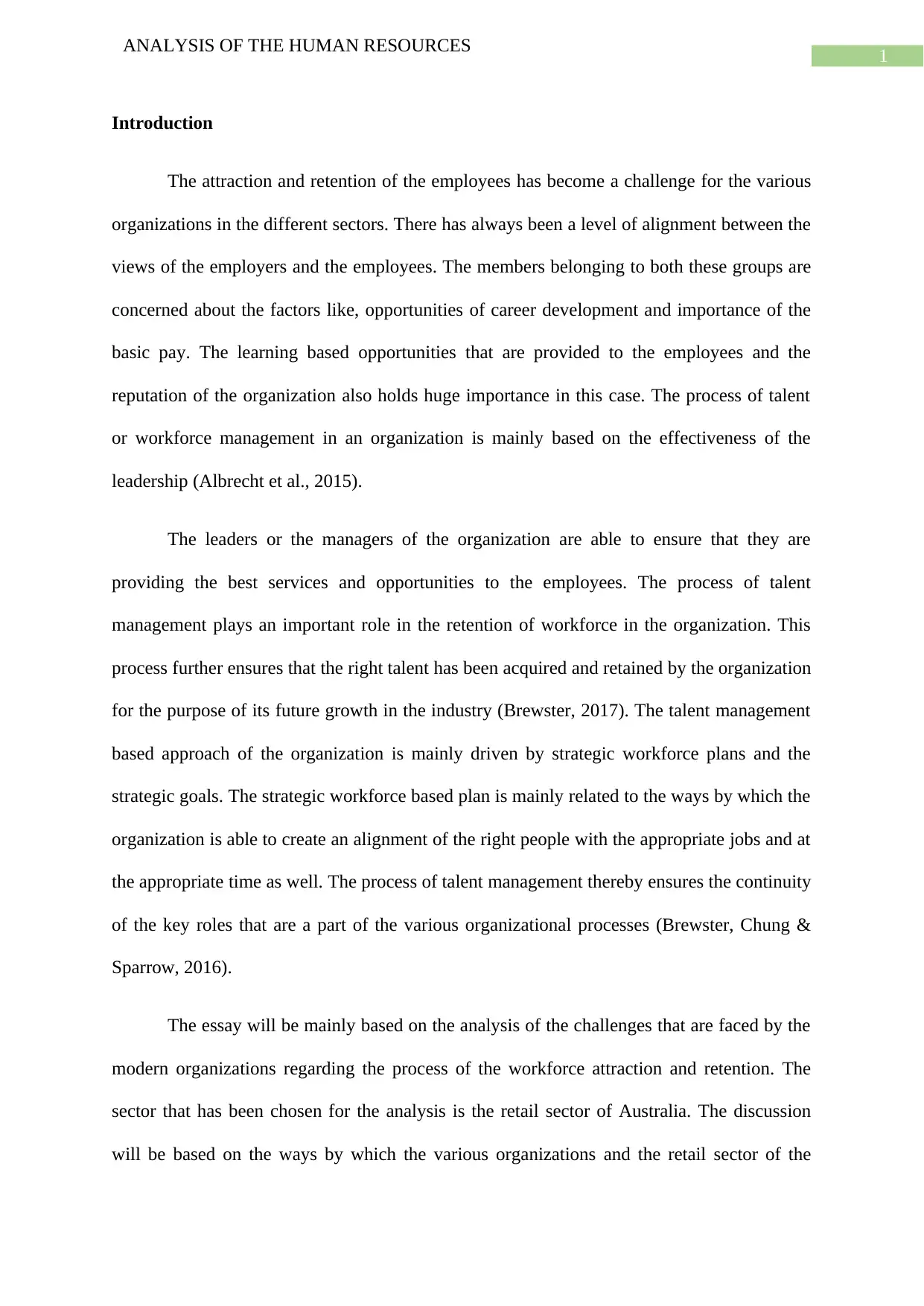
1
ANALYSIS OF THE HUMAN RESOURCES
Introduction
The attraction and retention of the employees has become a challenge for the various
organizations in the different sectors. There has always been a level of alignment between the
views of the employers and the employees. The members belonging to both these groups are
concerned about the factors like, opportunities of career development and importance of the
basic pay. The learning based opportunities that are provided to the employees and the
reputation of the organization also holds huge importance in this case. The process of talent
or workforce management in an organization is mainly based on the effectiveness of the
leadership (Albrecht et al., 2015).
The leaders or the managers of the organization are able to ensure that they are
providing the best services and opportunities to the employees. The process of talent
management plays an important role in the retention of workforce in the organization. This
process further ensures that the right talent has been acquired and retained by the organization
for the purpose of its future growth in the industry (Brewster, 2017). The talent management
based approach of the organization is mainly driven by strategic workforce plans and the
strategic goals. The strategic workforce based plan is mainly related to the ways by which the
organization is able to create an alignment of the right people with the appropriate jobs and at
the appropriate time as well. The process of talent management thereby ensures the continuity
of the key roles that are a part of the various organizational processes (Brewster, Chung &
Sparrow, 2016).
The essay will be mainly based on the analysis of the challenges that are faced by the
modern organizations regarding the process of the workforce attraction and retention. The
sector that has been chosen for the analysis is the retail sector of Australia. The discussion
will be based on the ways by which the various organizations and the retail sector of the
ANALYSIS OF THE HUMAN RESOURCES
Introduction
The attraction and retention of the employees has become a challenge for the various
organizations in the different sectors. There has always been a level of alignment between the
views of the employers and the employees. The members belonging to both these groups are
concerned about the factors like, opportunities of career development and importance of the
basic pay. The learning based opportunities that are provided to the employees and the
reputation of the organization also holds huge importance in this case. The process of talent
or workforce management in an organization is mainly based on the effectiveness of the
leadership (Albrecht et al., 2015).
The leaders or the managers of the organization are able to ensure that they are
providing the best services and opportunities to the employees. The process of talent
management plays an important role in the retention of workforce in the organization. This
process further ensures that the right talent has been acquired and retained by the organization
for the purpose of its future growth in the industry (Brewster, 2017). The talent management
based approach of the organization is mainly driven by strategic workforce plans and the
strategic goals. The strategic workforce based plan is mainly related to the ways by which the
organization is able to create an alignment of the right people with the appropriate jobs and at
the appropriate time as well. The process of talent management thereby ensures the continuity
of the key roles that are a part of the various organizational processes (Brewster, Chung &
Sparrow, 2016).
The essay will be mainly based on the analysis of the challenges that are faced by the
modern organizations regarding the process of the workforce attraction and retention. The
sector that has been chosen for the analysis is the retail sector of Australia. The discussion
will be based on the ways by which the various organizations and the retail sector of the
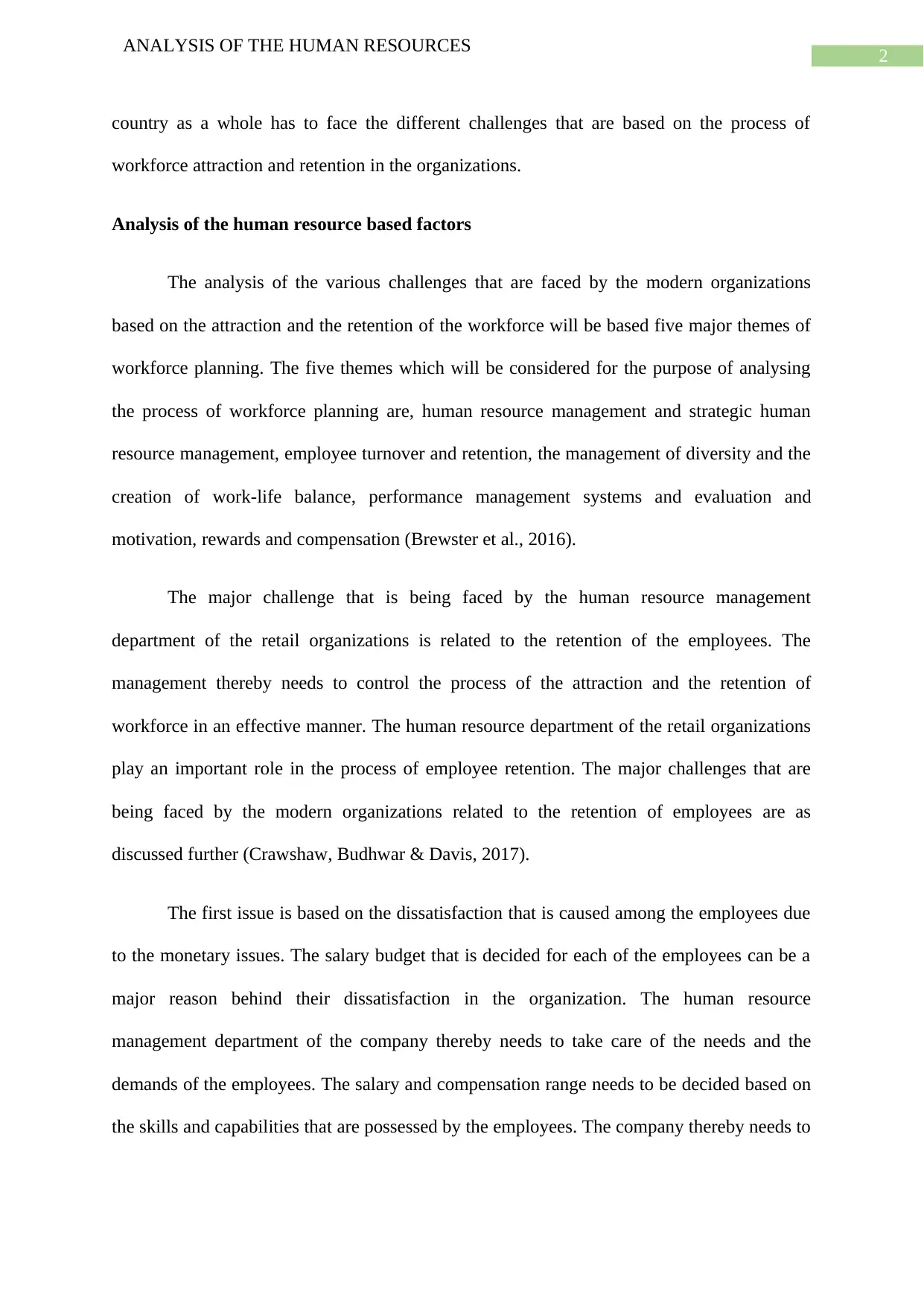
2
ANALYSIS OF THE HUMAN RESOURCES
country as a whole has to face the different challenges that are based on the process of
workforce attraction and retention in the organizations.
Analysis of the human resource based factors
The analysis of the various challenges that are faced by the modern organizations
based on the attraction and the retention of the workforce will be based five major themes of
workforce planning. The five themes which will be considered for the purpose of analysing
the process of workforce planning are, human resource management and strategic human
resource management, employee turnover and retention, the management of diversity and the
creation of work-life balance, performance management systems and evaluation and
motivation, rewards and compensation (Brewster et al., 2016).
The major challenge that is being faced by the human resource management
department of the retail organizations is related to the retention of the employees. The
management thereby needs to control the process of the attraction and the retention of
workforce in an effective manner. The human resource department of the retail organizations
play an important role in the process of employee retention. The major challenges that are
being faced by the modern organizations related to the retention of employees are as
discussed further (Crawshaw, Budhwar & Davis, 2017).
The first issue is based on the dissatisfaction that is caused among the employees due
to the monetary issues. The salary budget that is decided for each of the employees can be a
major reason behind their dissatisfaction in the organization. The human resource
management department of the company thereby needs to take care of the needs and the
demands of the employees. The salary and compensation range needs to be decided based on
the skills and capabilities that are possessed by the employees. The company thereby needs to
ANALYSIS OF THE HUMAN RESOURCES
country as a whole has to face the different challenges that are based on the process of
workforce attraction and retention in the organizations.
Analysis of the human resource based factors
The analysis of the various challenges that are faced by the modern organizations
based on the attraction and the retention of the workforce will be based five major themes of
workforce planning. The five themes which will be considered for the purpose of analysing
the process of workforce planning are, human resource management and strategic human
resource management, employee turnover and retention, the management of diversity and the
creation of work-life balance, performance management systems and evaluation and
motivation, rewards and compensation (Brewster et al., 2016).
The major challenge that is being faced by the human resource management
department of the retail organizations is related to the retention of the employees. The
management thereby needs to control the process of the attraction and the retention of
workforce in an effective manner. The human resource department of the retail organizations
play an important role in the process of employee retention. The major challenges that are
being faced by the modern organizations related to the retention of employees are as
discussed further (Crawshaw, Budhwar & Davis, 2017).
The first issue is based on the dissatisfaction that is caused among the employees due
to the monetary issues. The salary budget that is decided for each of the employees can be a
major reason behind their dissatisfaction in the organization. The human resource
management department of the company thereby needs to take care of the needs and the
demands of the employees. The salary and compensation range needs to be decided based on
the skills and capabilities that are possessed by the employees. The company thereby needs to
⊘ This is a preview!⊘
Do you want full access?
Subscribe today to unlock all pages.

Trusted by 1+ million students worldwide
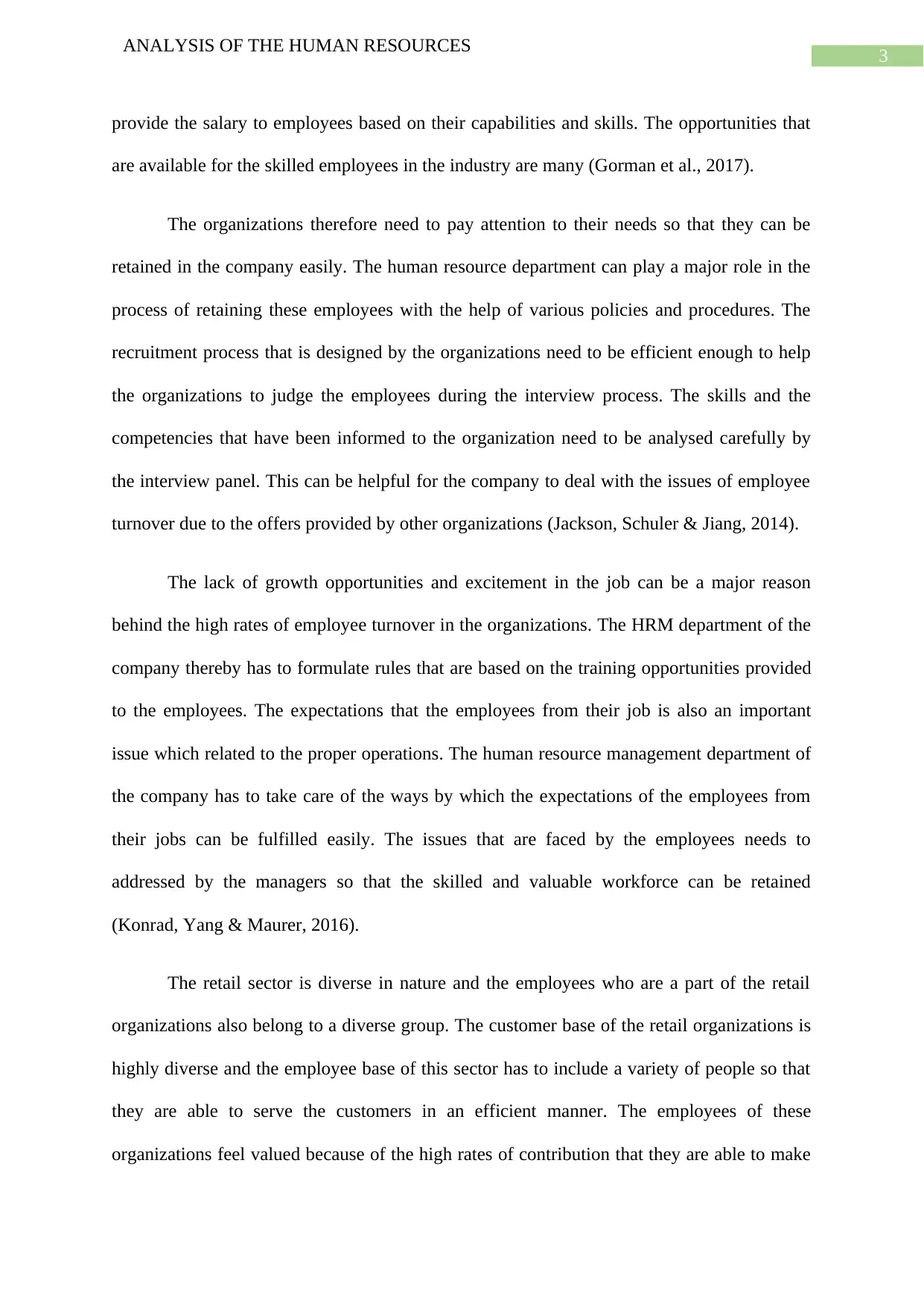
3
ANALYSIS OF THE HUMAN RESOURCES
provide the salary to employees based on their capabilities and skills. The opportunities that
are available for the skilled employees in the industry are many (Gorman et al., 2017).
The organizations therefore need to pay attention to their needs so that they can be
retained in the company easily. The human resource department can play a major role in the
process of retaining these employees with the help of various policies and procedures. The
recruitment process that is designed by the organizations need to be efficient enough to help
the organizations to judge the employees during the interview process. The skills and the
competencies that have been informed to the organization need to be analysed carefully by
the interview panel. This can be helpful for the company to deal with the issues of employee
turnover due to the offers provided by other organizations (Jackson, Schuler & Jiang, 2014).
The lack of growth opportunities and excitement in the job can be a major reason
behind the high rates of employee turnover in the organizations. The HRM department of the
company thereby has to formulate rules that are based on the training opportunities provided
to the employees. The expectations that the employees from their job is also an important
issue which related to the proper operations. The human resource management department of
the company has to take care of the ways by which the expectations of the employees from
their jobs can be fulfilled easily. The issues that are faced by the employees needs to
addressed by the managers so that the skilled and valuable workforce can be retained
(Konrad, Yang & Maurer, 2016).
The retail sector is diverse in nature and the employees who are a part of the retail
organizations also belong to a diverse group. The customer base of the retail organizations is
highly diverse and the employee base of this sector has to include a variety of people so that
they are able to serve the customers in an efficient manner. The employees of these
organizations feel valued because of the high rates of contribution that they are able to make
ANALYSIS OF THE HUMAN RESOURCES
provide the salary to employees based on their capabilities and skills. The opportunities that
are available for the skilled employees in the industry are many (Gorman et al., 2017).
The organizations therefore need to pay attention to their needs so that they can be
retained in the company easily. The human resource department can play a major role in the
process of retaining these employees with the help of various policies and procedures. The
recruitment process that is designed by the organizations need to be efficient enough to help
the organizations to judge the employees during the interview process. The skills and the
competencies that have been informed to the organization need to be analysed carefully by
the interview panel. This can be helpful for the company to deal with the issues of employee
turnover due to the offers provided by other organizations (Jackson, Schuler & Jiang, 2014).
The lack of growth opportunities and excitement in the job can be a major reason
behind the high rates of employee turnover in the organizations. The HRM department of the
company thereby has to formulate rules that are based on the training opportunities provided
to the employees. The expectations that the employees from their job is also an important
issue which related to the proper operations. The human resource management department of
the company has to take care of the ways by which the expectations of the employees from
their jobs can be fulfilled easily. The issues that are faced by the employees needs to
addressed by the managers so that the skilled and valuable workforce can be retained
(Konrad, Yang & Maurer, 2016).
The retail sector is diverse in nature and the employees who are a part of the retail
organizations also belong to a diverse group. The customer base of the retail organizations is
highly diverse and the employee base of this sector has to include a variety of people so that
they are able to serve the customers in an efficient manner. The employees of these
organizations feel valued because of the high rates of contribution that they are able to make
Paraphrase This Document
Need a fresh take? Get an instant paraphrase of this document with our AI Paraphraser
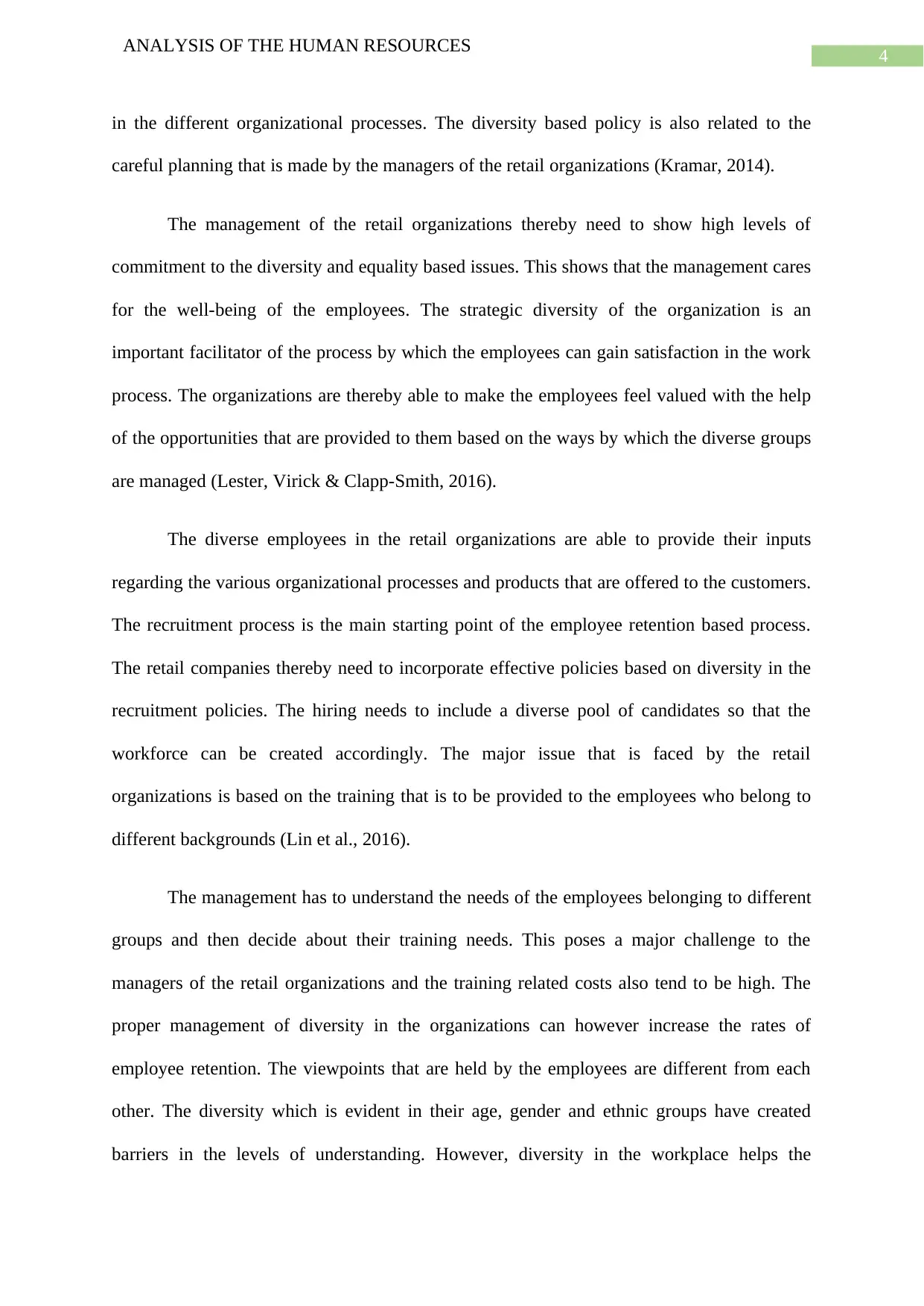
4
ANALYSIS OF THE HUMAN RESOURCES
in the different organizational processes. The diversity based policy is also related to the
careful planning that is made by the managers of the retail organizations (Kramar, 2014).
The management of the retail organizations thereby need to show high levels of
commitment to the diversity and equality based issues. This shows that the management cares
for the well-being of the employees. The strategic diversity of the organization is an
important facilitator of the process by which the employees can gain satisfaction in the work
process. The organizations are thereby able to make the employees feel valued with the help
of the opportunities that are provided to them based on the ways by which the diverse groups
are managed (Lester, Virick & Clapp-Smith, 2016).
The diverse employees in the retail organizations are able to provide their inputs
regarding the various organizational processes and products that are offered to the customers.
The recruitment process is the main starting point of the employee retention based process.
The retail companies thereby need to incorporate effective policies based on diversity in the
recruitment policies. The hiring needs to include a diverse pool of candidates so that the
workforce can be created accordingly. The major issue that is faced by the retail
organizations is based on the training that is to be provided to the employees who belong to
different backgrounds (Lin et al., 2016).
The management has to understand the needs of the employees belonging to different
groups and then decide about their training needs. This poses a major challenge to the
managers of the retail organizations and the training related costs also tend to be high. The
proper management of diversity in the organizations can however increase the rates of
employee retention. The viewpoints that are held by the employees are different from each
other. The diversity which is evident in their age, gender and ethnic groups have created
barriers in the levels of understanding. However, diversity in the workplace helps the
ANALYSIS OF THE HUMAN RESOURCES
in the different organizational processes. The diversity based policy is also related to the
careful planning that is made by the managers of the retail organizations (Kramar, 2014).
The management of the retail organizations thereby need to show high levels of
commitment to the diversity and equality based issues. This shows that the management cares
for the well-being of the employees. The strategic diversity of the organization is an
important facilitator of the process by which the employees can gain satisfaction in the work
process. The organizations are thereby able to make the employees feel valued with the help
of the opportunities that are provided to them based on the ways by which the diverse groups
are managed (Lester, Virick & Clapp-Smith, 2016).
The diverse employees in the retail organizations are able to provide their inputs
regarding the various organizational processes and products that are offered to the customers.
The recruitment process is the main starting point of the employee retention based process.
The retail companies thereby need to incorporate effective policies based on diversity in the
recruitment policies. The hiring needs to include a diverse pool of candidates so that the
workforce can be created accordingly. The major issue that is faced by the retail
organizations is based on the training that is to be provided to the employees who belong to
different backgrounds (Lin et al., 2016).
The management has to understand the needs of the employees belonging to different
groups and then decide about their training needs. This poses a major challenge to the
managers of the retail organizations and the training related costs also tend to be high. The
proper management of diversity in the organizations can however increase the rates of
employee retention. The viewpoints that are held by the employees are different from each
other. The diversity which is evident in their age, gender and ethnic groups have created
barriers in the levels of understanding. However, diversity in the workplace helps the
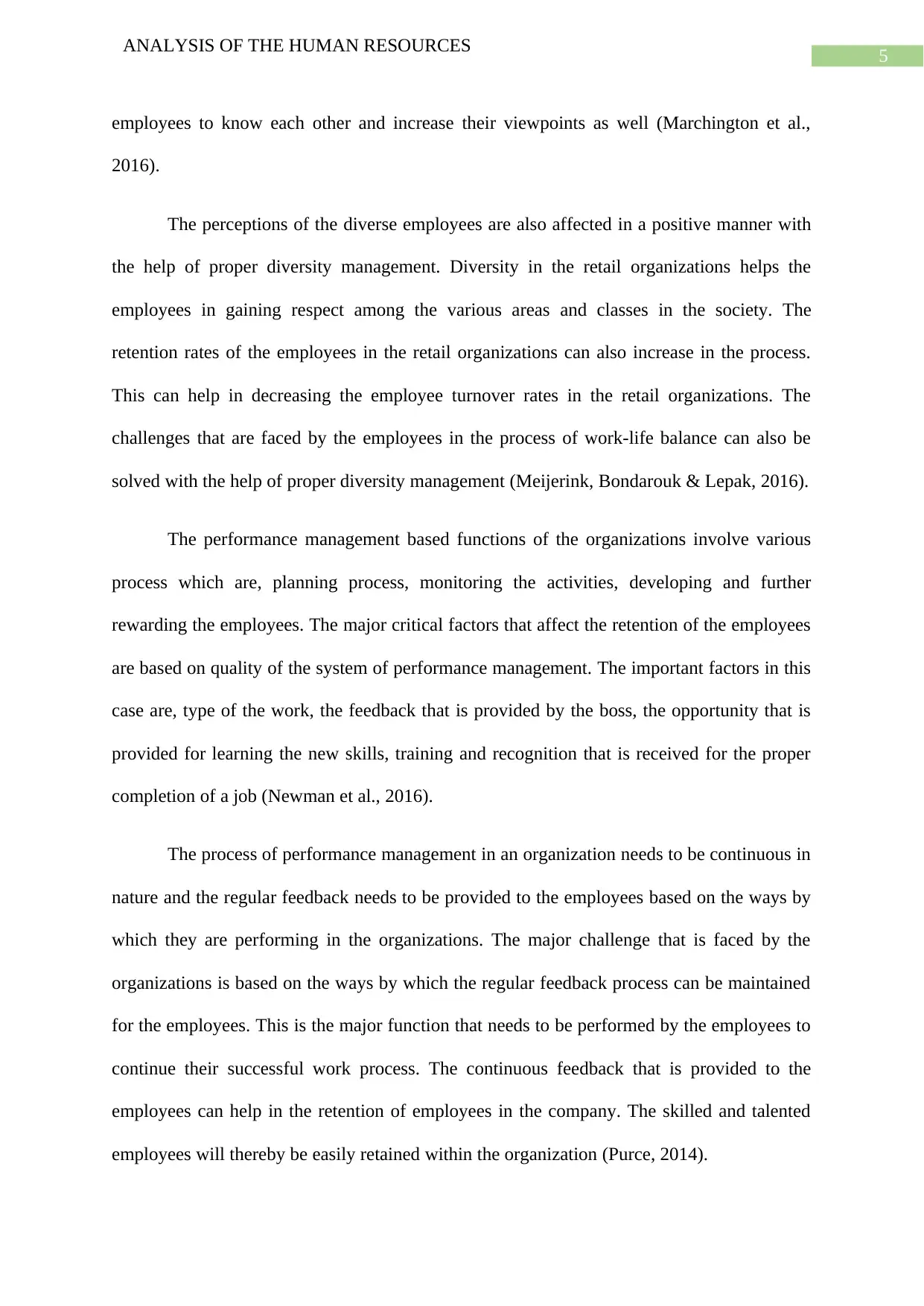
5
ANALYSIS OF THE HUMAN RESOURCES
employees to know each other and increase their viewpoints as well (Marchington et al.,
2016).
The perceptions of the diverse employees are also affected in a positive manner with
the help of proper diversity management. Diversity in the retail organizations helps the
employees in gaining respect among the various areas and classes in the society. The
retention rates of the employees in the retail organizations can also increase in the process.
This can help in decreasing the employee turnover rates in the retail organizations. The
challenges that are faced by the employees in the process of work-life balance can also be
solved with the help of proper diversity management (Meijerink, Bondarouk & Lepak, 2016).
The performance management based functions of the organizations involve various
process which are, planning process, monitoring the activities, developing and further
rewarding the employees. The major critical factors that affect the retention of the employees
are based on quality of the system of performance management. The important factors in this
case are, type of the work, the feedback that is provided by the boss, the opportunity that is
provided for learning the new skills, training and recognition that is received for the proper
completion of a job (Newman et al., 2016).
The process of performance management in an organization needs to be continuous in
nature and the regular feedback needs to be provided to the employees based on the ways by
which they are performing in the organizations. The major challenge that is faced by the
organizations is based on the ways by which the regular feedback process can be maintained
for the employees. This is the major function that needs to be performed by the employees to
continue their successful work process. The continuous feedback that is provided to the
employees can help in the retention of employees in the company. The skilled and talented
employees will thereby be easily retained within the organization (Purce, 2014).
ANALYSIS OF THE HUMAN RESOURCES
employees to know each other and increase their viewpoints as well (Marchington et al.,
2016).
The perceptions of the diverse employees are also affected in a positive manner with
the help of proper diversity management. Diversity in the retail organizations helps the
employees in gaining respect among the various areas and classes in the society. The
retention rates of the employees in the retail organizations can also increase in the process.
This can help in decreasing the employee turnover rates in the retail organizations. The
challenges that are faced by the employees in the process of work-life balance can also be
solved with the help of proper diversity management (Meijerink, Bondarouk & Lepak, 2016).
The performance management based functions of the organizations involve various
process which are, planning process, monitoring the activities, developing and further
rewarding the employees. The major critical factors that affect the retention of the employees
are based on quality of the system of performance management. The important factors in this
case are, type of the work, the feedback that is provided by the boss, the opportunity that is
provided for learning the new skills, training and recognition that is received for the proper
completion of a job (Newman et al., 2016).
The process of performance management in an organization needs to be continuous in
nature and the regular feedback needs to be provided to the employees based on the ways by
which they are performing in the organizations. The major challenge that is faced by the
organizations is based on the ways by which the regular feedback process can be maintained
for the employees. This is the major function that needs to be performed by the employees to
continue their successful work process. The continuous feedback that is provided to the
employees can help in the retention of employees in the company. The skilled and talented
employees will thereby be easily retained within the organization (Purce, 2014).
⊘ This is a preview!⊘
Do you want full access?
Subscribe today to unlock all pages.

Trusted by 1+ million students worldwide
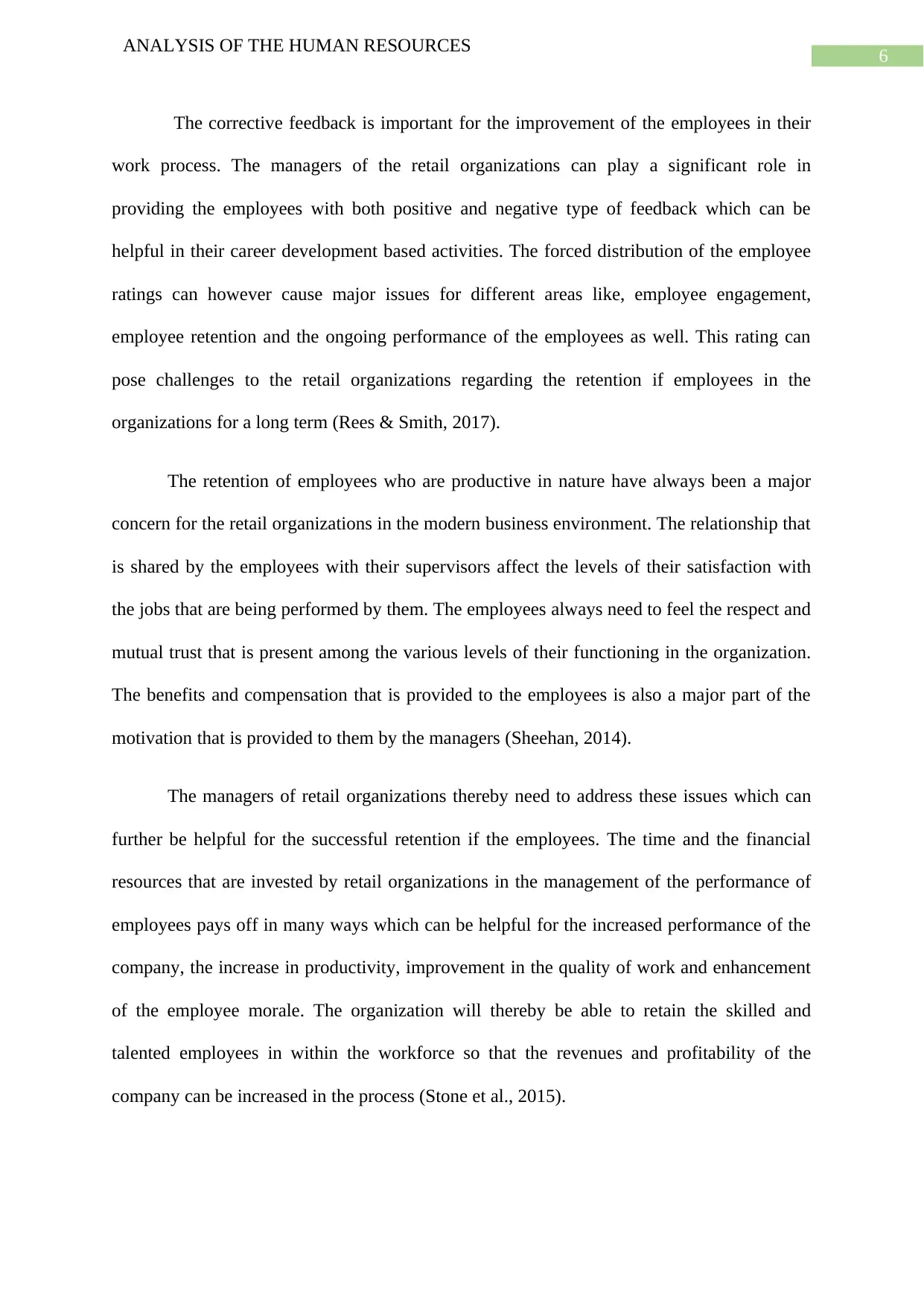
6
ANALYSIS OF THE HUMAN RESOURCES
The corrective feedback is important for the improvement of the employees in their
work process. The managers of the retail organizations can play a significant role in
providing the employees with both positive and negative type of feedback which can be
helpful in their career development based activities. The forced distribution of the employee
ratings can however cause major issues for different areas like, employee engagement,
employee retention and the ongoing performance of the employees as well. This rating can
pose challenges to the retail organizations regarding the retention if employees in the
organizations for a long term (Rees & Smith, 2017).
The retention of employees who are productive in nature have always been a major
concern for the retail organizations in the modern business environment. The relationship that
is shared by the employees with their supervisors affect the levels of their satisfaction with
the jobs that are being performed by them. The employees always need to feel the respect and
mutual trust that is present among the various levels of their functioning in the organization.
The benefits and compensation that is provided to the employees is also a major part of the
motivation that is provided to them by the managers (Sheehan, 2014).
The managers of retail organizations thereby need to address these issues which can
further be helpful for the successful retention if the employees. The time and the financial
resources that are invested by retail organizations in the management of the performance of
employees pays off in many ways which can be helpful for the increased performance of the
company, the increase in productivity, improvement in the quality of work and enhancement
of the employee morale. The organization will thereby be able to retain the skilled and
talented employees in within the workforce so that the revenues and profitability of the
company can be increased in the process (Stone et al., 2015).
ANALYSIS OF THE HUMAN RESOURCES
The corrective feedback is important for the improvement of the employees in their
work process. The managers of the retail organizations can play a significant role in
providing the employees with both positive and negative type of feedback which can be
helpful in their career development based activities. The forced distribution of the employee
ratings can however cause major issues for different areas like, employee engagement,
employee retention and the ongoing performance of the employees as well. This rating can
pose challenges to the retail organizations regarding the retention if employees in the
organizations for a long term (Rees & Smith, 2017).
The retention of employees who are productive in nature have always been a major
concern for the retail organizations in the modern business environment. The relationship that
is shared by the employees with their supervisors affect the levels of their satisfaction with
the jobs that are being performed by them. The employees always need to feel the respect and
mutual trust that is present among the various levels of their functioning in the organization.
The benefits and compensation that is provided to the employees is also a major part of the
motivation that is provided to them by the managers (Sheehan, 2014).
The managers of retail organizations thereby need to address these issues which can
further be helpful for the successful retention if the employees. The time and the financial
resources that are invested by retail organizations in the management of the performance of
employees pays off in many ways which can be helpful for the increased performance of the
company, the increase in productivity, improvement in the quality of work and enhancement
of the employee morale. The organization will thereby be able to retain the skilled and
talented employees in within the workforce so that the revenues and profitability of the
company can be increased in the process (Stone et al., 2015).
Paraphrase This Document
Need a fresh take? Get an instant paraphrase of this document with our AI Paraphraser
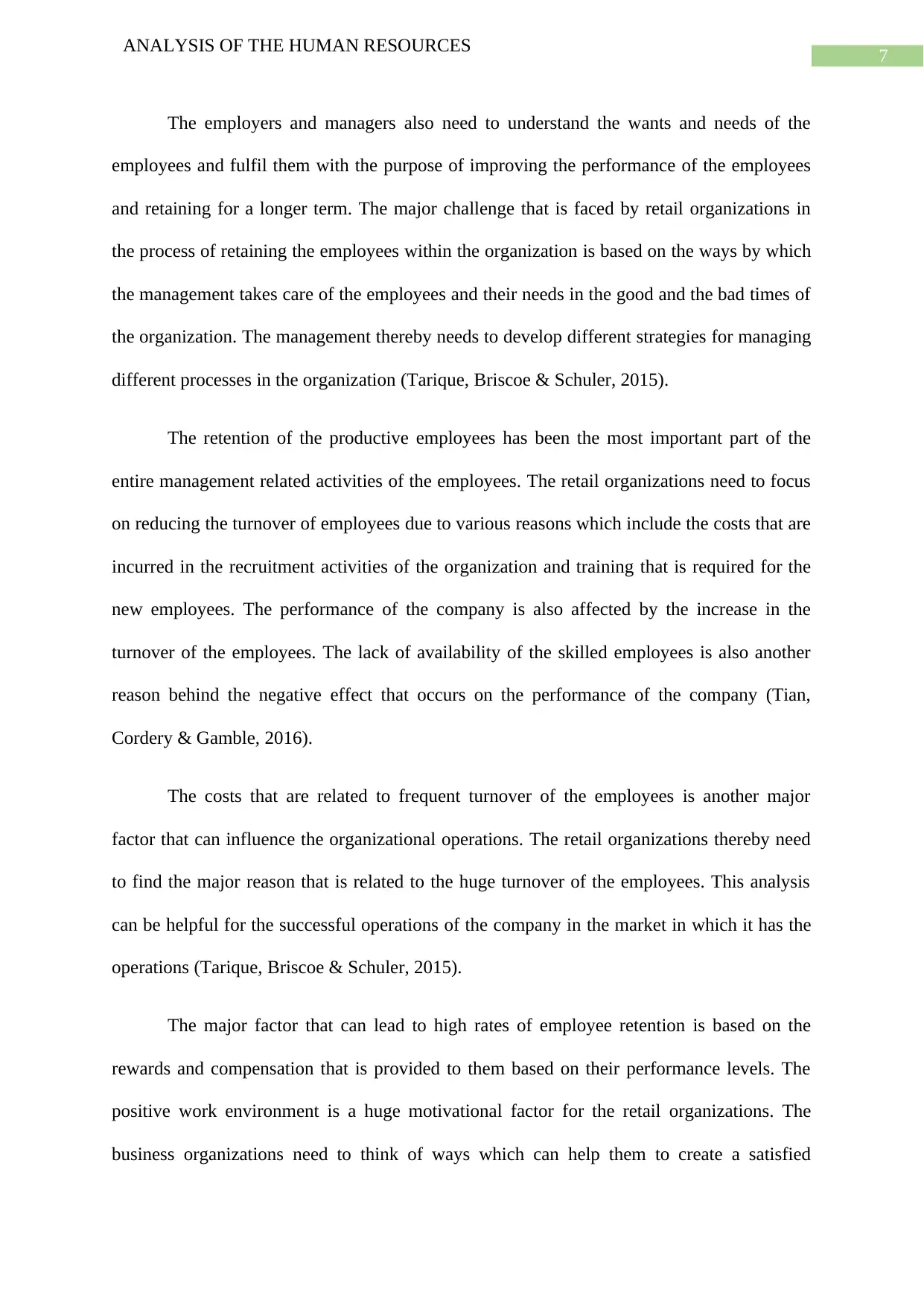
7
ANALYSIS OF THE HUMAN RESOURCES
The employers and managers also need to understand the wants and needs of the
employees and fulfil them with the purpose of improving the performance of the employees
and retaining for a longer term. The major challenge that is faced by retail organizations in
the process of retaining the employees within the organization is based on the ways by which
the management takes care of the employees and their needs in the good and the bad times of
the organization. The management thereby needs to develop different strategies for managing
different processes in the organization (Tarique, Briscoe & Schuler, 2015).
The retention of the productive employees has been the most important part of the
entire management related activities of the employees. The retail organizations need to focus
on reducing the turnover of employees due to various reasons which include the costs that are
incurred in the recruitment activities of the organization and training that is required for the
new employees. The performance of the company is also affected by the increase in the
turnover of the employees. The lack of availability of the skilled employees is also another
reason behind the negative effect that occurs on the performance of the company (Tian,
Cordery & Gamble, 2016).
The costs that are related to frequent turnover of the employees is another major
factor that can influence the organizational operations. The retail organizations thereby need
to find the major reason that is related to the huge turnover of the employees. This analysis
can be helpful for the successful operations of the company in the market in which it has the
operations (Tarique, Briscoe & Schuler, 2015).
The major factor that can lead to high rates of employee retention is based on the
rewards and compensation that is provided to them based on their performance levels. The
positive work environment is a huge motivational factor for the retail organizations. The
business organizations need to think of ways which can help them to create a satisfied
ANALYSIS OF THE HUMAN RESOURCES
The employers and managers also need to understand the wants and needs of the
employees and fulfil them with the purpose of improving the performance of the employees
and retaining for a longer term. The major challenge that is faced by retail organizations in
the process of retaining the employees within the organization is based on the ways by which
the management takes care of the employees and their needs in the good and the bad times of
the organization. The management thereby needs to develop different strategies for managing
different processes in the organization (Tarique, Briscoe & Schuler, 2015).
The retention of the productive employees has been the most important part of the
entire management related activities of the employees. The retail organizations need to focus
on reducing the turnover of employees due to various reasons which include the costs that are
incurred in the recruitment activities of the organization and training that is required for the
new employees. The performance of the company is also affected by the increase in the
turnover of the employees. The lack of availability of the skilled employees is also another
reason behind the negative effect that occurs on the performance of the company (Tian,
Cordery & Gamble, 2016).
The costs that are related to frequent turnover of the employees is another major
factor that can influence the organizational operations. The retail organizations thereby need
to find the major reason that is related to the huge turnover of the employees. This analysis
can be helpful for the successful operations of the company in the market in which it has the
operations (Tarique, Briscoe & Schuler, 2015).
The major factor that can lead to high rates of employee retention is based on the
rewards and compensation that is provided to them based on their performance levels. The
positive work environment is a huge motivational factor for the retail organizations. The
business organizations need to think of ways which can help them to create a satisfied
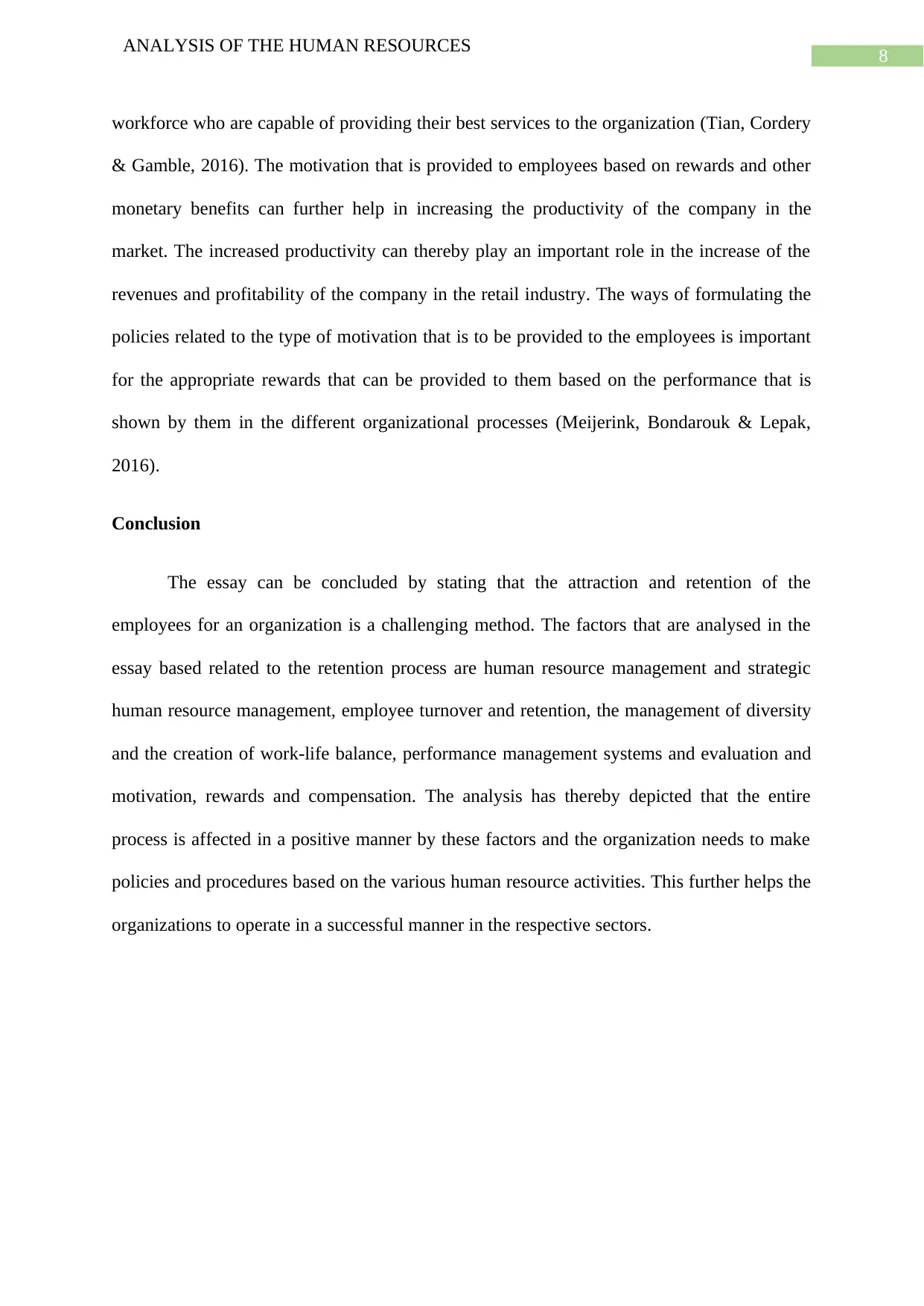
8
ANALYSIS OF THE HUMAN RESOURCES
workforce who are capable of providing their best services to the organization (Tian, Cordery
& Gamble, 2016). The motivation that is provided to employees based on rewards and other
monetary benefits can further help in increasing the productivity of the company in the
market. The increased productivity can thereby play an important role in the increase of the
revenues and profitability of the company in the retail industry. The ways of formulating the
policies related to the type of motivation that is to be provided to the employees is important
for the appropriate rewards that can be provided to them based on the performance that is
shown by them in the different organizational processes (Meijerink, Bondarouk & Lepak,
2016).
Conclusion
The essay can be concluded by stating that the attraction and retention of the
employees for an organization is a challenging method. The factors that are analysed in the
essay based related to the retention process are human resource management and strategic
human resource management, employee turnover and retention, the management of diversity
and the creation of work-life balance, performance management systems and evaluation and
motivation, rewards and compensation. The analysis has thereby depicted that the entire
process is affected in a positive manner by these factors and the organization needs to make
policies and procedures based on the various human resource activities. This further helps the
organizations to operate in a successful manner in the respective sectors.
ANALYSIS OF THE HUMAN RESOURCES
workforce who are capable of providing their best services to the organization (Tian, Cordery
& Gamble, 2016). The motivation that is provided to employees based on rewards and other
monetary benefits can further help in increasing the productivity of the company in the
market. The increased productivity can thereby play an important role in the increase of the
revenues and profitability of the company in the retail industry. The ways of formulating the
policies related to the type of motivation that is to be provided to the employees is important
for the appropriate rewards that can be provided to them based on the performance that is
shown by them in the different organizational processes (Meijerink, Bondarouk & Lepak,
2016).
Conclusion
The essay can be concluded by stating that the attraction and retention of the
employees for an organization is a challenging method. The factors that are analysed in the
essay based related to the retention process are human resource management and strategic
human resource management, employee turnover and retention, the management of diversity
and the creation of work-life balance, performance management systems and evaluation and
motivation, rewards and compensation. The analysis has thereby depicted that the entire
process is affected in a positive manner by these factors and the organization needs to make
policies and procedures based on the various human resource activities. This further helps the
organizations to operate in a successful manner in the respective sectors.
⊘ This is a preview!⊘
Do you want full access?
Subscribe today to unlock all pages.

Trusted by 1+ million students worldwide
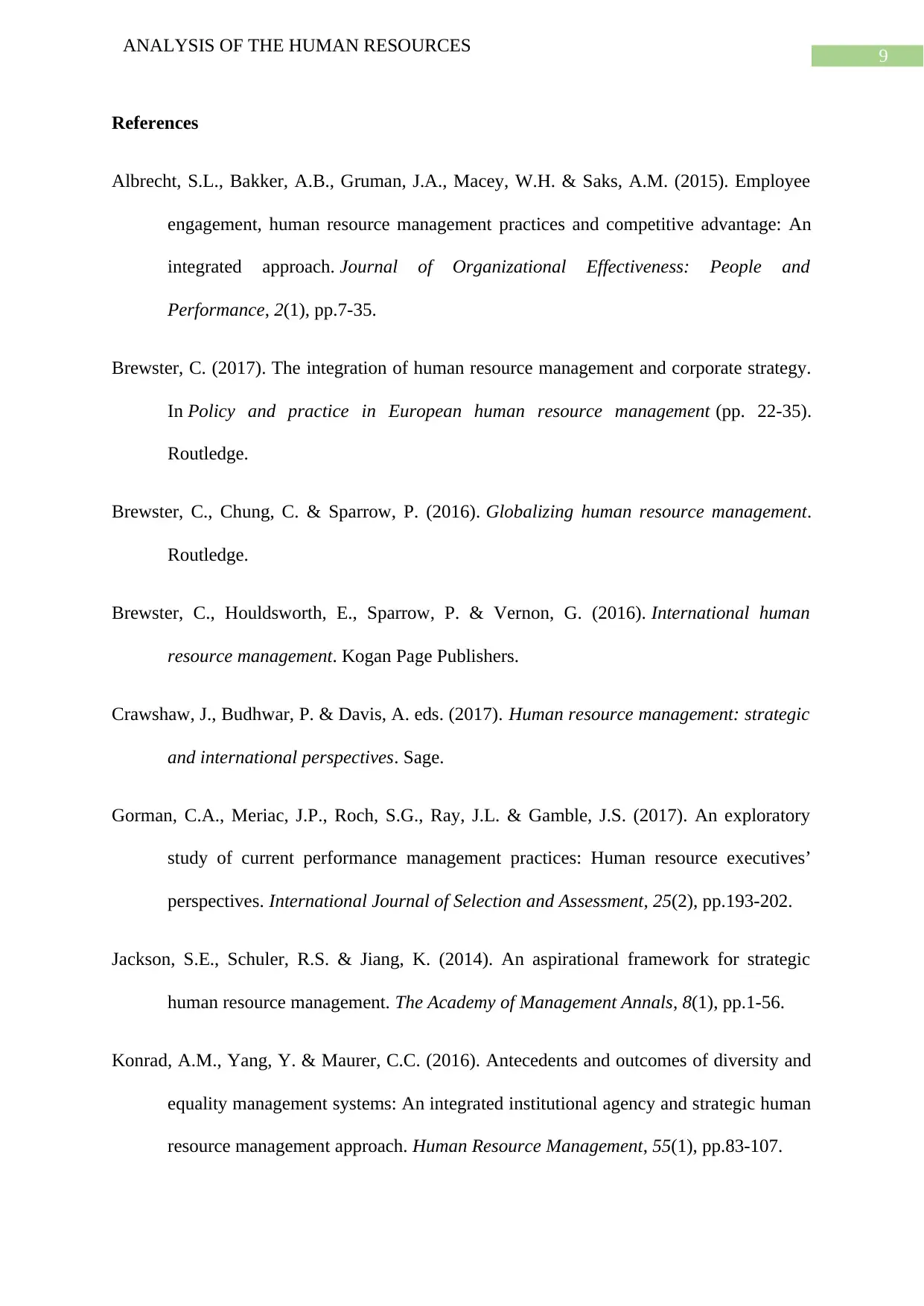
9
ANALYSIS OF THE HUMAN RESOURCES
References
Albrecht, S.L., Bakker, A.B., Gruman, J.A., Macey, W.H. & Saks, A.M. (2015). Employee
engagement, human resource management practices and competitive advantage: An
integrated approach. Journal of Organizational Effectiveness: People and
Performance, 2(1), pp.7-35.
Brewster, C. (2017). The integration of human resource management and corporate strategy.
In Policy and practice in European human resource management (pp. 22-35).
Routledge.
Brewster, C., Chung, C. & Sparrow, P. (2016). Globalizing human resource management.
Routledge.
Brewster, C., Houldsworth, E., Sparrow, P. & Vernon, G. (2016). International human
resource management. Kogan Page Publishers.
Crawshaw, J., Budhwar, P. & Davis, A. eds. (2017). Human resource management: strategic
and international perspectives. Sage.
Gorman, C.A., Meriac, J.P., Roch, S.G., Ray, J.L. & Gamble, J.S. (2017). An exploratory
study of current performance management practices: Human resource executives’
perspectives. International Journal of Selection and Assessment, 25(2), pp.193-202.
Jackson, S.E., Schuler, R.S. & Jiang, K. (2014). An aspirational framework for strategic
human resource management. The Academy of Management Annals, 8(1), pp.1-56.
Konrad, A.M., Yang, Y. & Maurer, C.C. (2016). Antecedents and outcomes of diversity and
equality management systems: An integrated institutional agency and strategic human
resource management approach. Human Resource Management, 55(1), pp.83-107.
ANALYSIS OF THE HUMAN RESOURCES
References
Albrecht, S.L., Bakker, A.B., Gruman, J.A., Macey, W.H. & Saks, A.M. (2015). Employee
engagement, human resource management practices and competitive advantage: An
integrated approach. Journal of Organizational Effectiveness: People and
Performance, 2(1), pp.7-35.
Brewster, C. (2017). The integration of human resource management and corporate strategy.
In Policy and practice in European human resource management (pp. 22-35).
Routledge.
Brewster, C., Chung, C. & Sparrow, P. (2016). Globalizing human resource management.
Routledge.
Brewster, C., Houldsworth, E., Sparrow, P. & Vernon, G. (2016). International human
resource management. Kogan Page Publishers.
Crawshaw, J., Budhwar, P. & Davis, A. eds. (2017). Human resource management: strategic
and international perspectives. Sage.
Gorman, C.A., Meriac, J.P., Roch, S.G., Ray, J.L. & Gamble, J.S. (2017). An exploratory
study of current performance management practices: Human resource executives’
perspectives. International Journal of Selection and Assessment, 25(2), pp.193-202.
Jackson, S.E., Schuler, R.S. & Jiang, K. (2014). An aspirational framework for strategic
human resource management. The Academy of Management Annals, 8(1), pp.1-56.
Konrad, A.M., Yang, Y. & Maurer, C.C. (2016). Antecedents and outcomes of diversity and
equality management systems: An integrated institutional agency and strategic human
resource management approach. Human Resource Management, 55(1), pp.83-107.
Paraphrase This Document
Need a fresh take? Get an instant paraphrase of this document with our AI Paraphraser
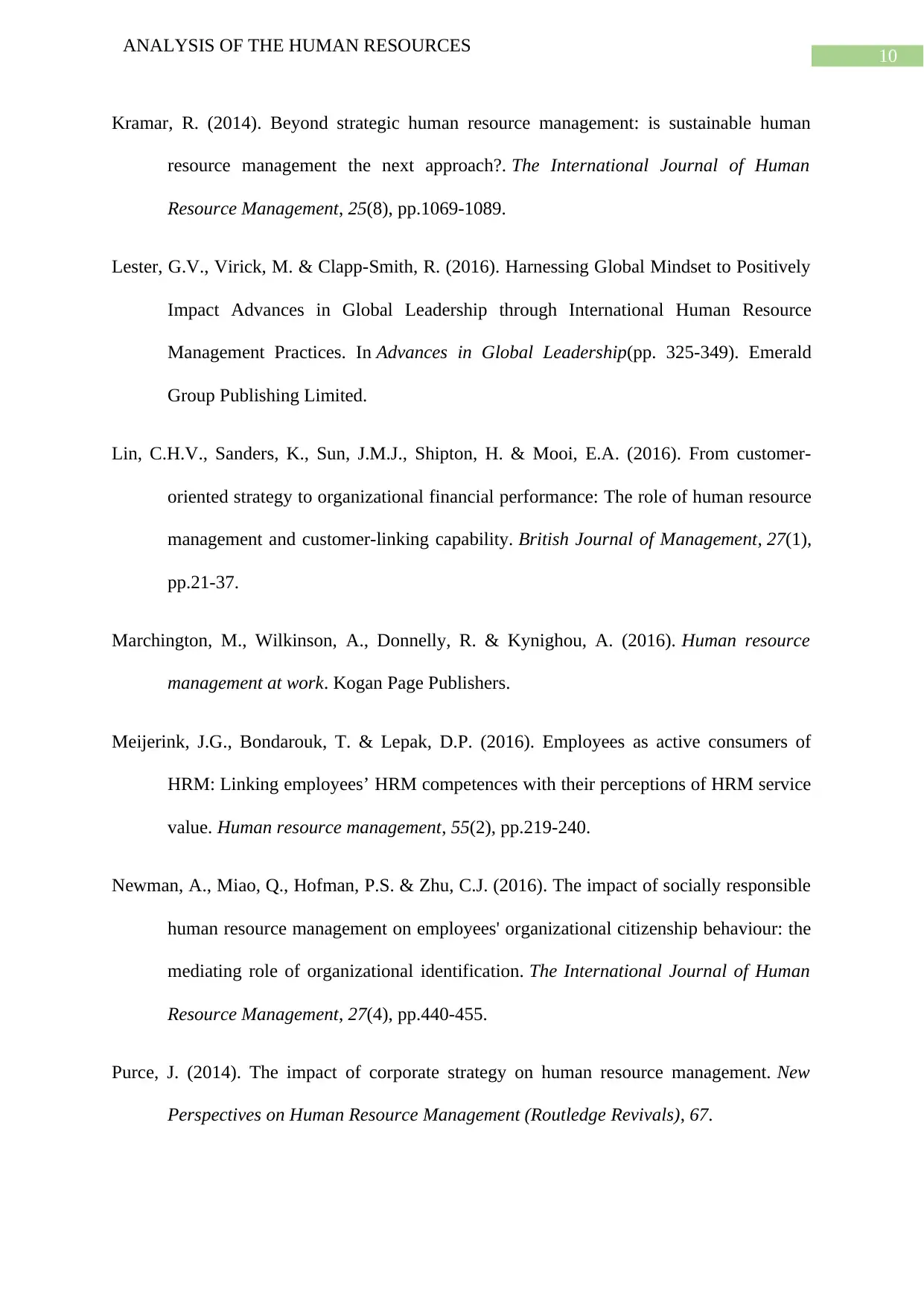
10
ANALYSIS OF THE HUMAN RESOURCES
Kramar, R. (2014). Beyond strategic human resource management: is sustainable human
resource management the next approach?. The International Journal of Human
Resource Management, 25(8), pp.1069-1089.
Lester, G.V., Virick, M. & Clapp-Smith, R. (2016). Harnessing Global Mindset to Positively
Impact Advances in Global Leadership through International Human Resource
Management Practices. In Advances in Global Leadership(pp. 325-349). Emerald
Group Publishing Limited.
Lin, C.H.V., Sanders, K., Sun, J.M.J., Shipton, H. & Mooi, E.A. (2016). From customer‐
oriented strategy to organizational financial performance: The role of human resource
management and customer‐linking capability. British Journal of Management, 27(1),
pp.21-37.
Marchington, M., Wilkinson, A., Donnelly, R. & Kynighou, A. (2016). Human resource
management at work. Kogan Page Publishers.
Meijerink, J.G., Bondarouk, T. & Lepak, D.P. (2016). Employees as active consumers of
HRM: Linking employees’ HRM competences with their perceptions of HRM service
value. Human resource management, 55(2), pp.219-240.
Newman, A., Miao, Q., Hofman, P.S. & Zhu, C.J. (2016). The impact of socially responsible
human resource management on employees' organizational citizenship behaviour: the
mediating role of organizational identification. The International Journal of Human
Resource Management, 27(4), pp.440-455.
Purce, J. (2014). The impact of corporate strategy on human resource management. New
Perspectives on Human Resource Management (Routledge Revivals), 67.
ANALYSIS OF THE HUMAN RESOURCES
Kramar, R. (2014). Beyond strategic human resource management: is sustainable human
resource management the next approach?. The International Journal of Human
Resource Management, 25(8), pp.1069-1089.
Lester, G.V., Virick, M. & Clapp-Smith, R. (2016). Harnessing Global Mindset to Positively
Impact Advances in Global Leadership through International Human Resource
Management Practices. In Advances in Global Leadership(pp. 325-349). Emerald
Group Publishing Limited.
Lin, C.H.V., Sanders, K., Sun, J.M.J., Shipton, H. & Mooi, E.A. (2016). From customer‐
oriented strategy to organizational financial performance: The role of human resource
management and customer‐linking capability. British Journal of Management, 27(1),
pp.21-37.
Marchington, M., Wilkinson, A., Donnelly, R. & Kynighou, A. (2016). Human resource
management at work. Kogan Page Publishers.
Meijerink, J.G., Bondarouk, T. & Lepak, D.P. (2016). Employees as active consumers of
HRM: Linking employees’ HRM competences with their perceptions of HRM service
value. Human resource management, 55(2), pp.219-240.
Newman, A., Miao, Q., Hofman, P.S. & Zhu, C.J. (2016). The impact of socially responsible
human resource management on employees' organizational citizenship behaviour: the
mediating role of organizational identification. The International Journal of Human
Resource Management, 27(4), pp.440-455.
Purce, J. (2014). The impact of corporate strategy on human resource management. New
Perspectives on Human Resource Management (Routledge Revivals), 67.
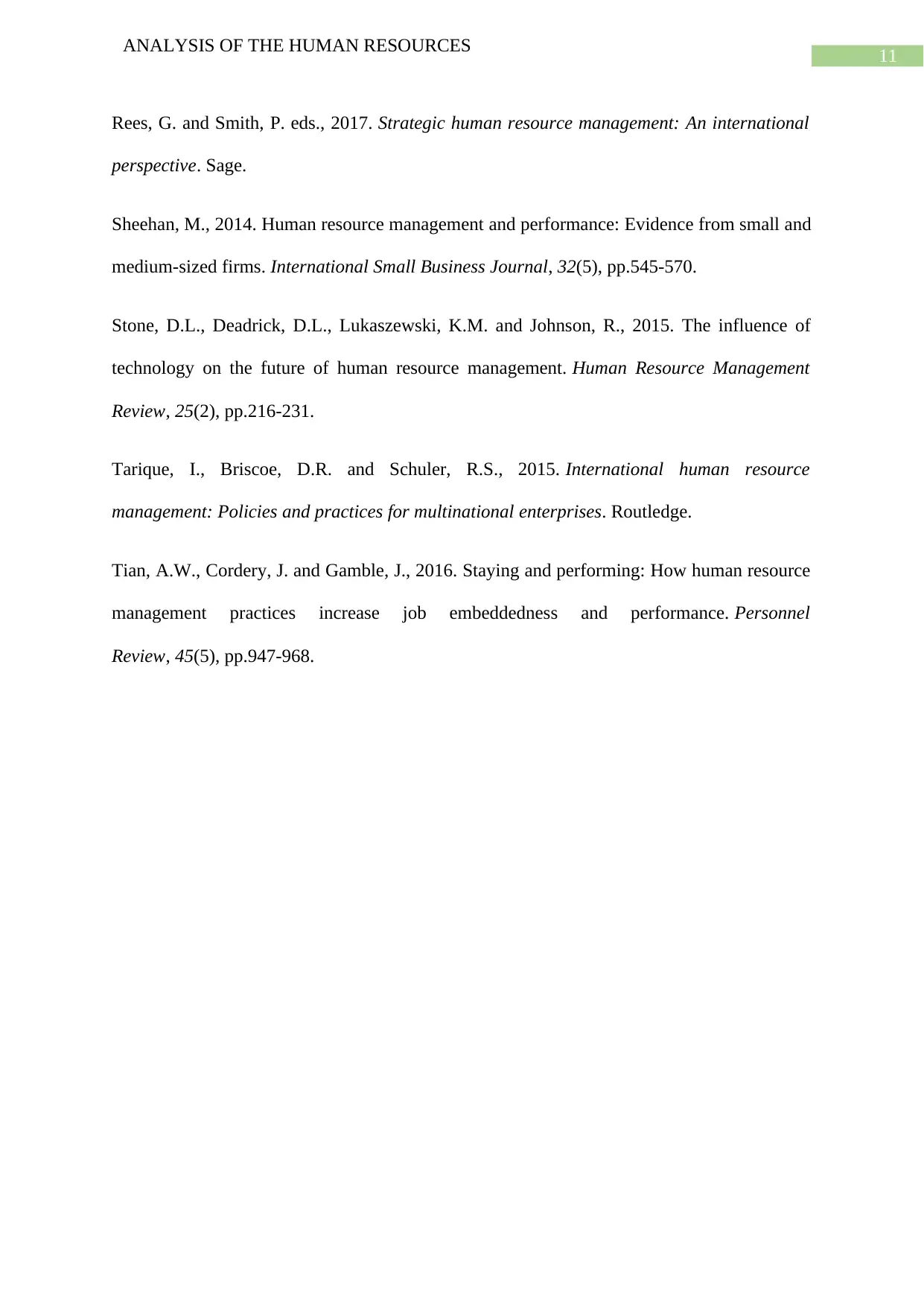
11
ANALYSIS OF THE HUMAN RESOURCES
Rees, G. and Smith, P. eds., 2017. Strategic human resource management: An international
perspective. Sage.
Sheehan, M., 2014. Human resource management and performance: Evidence from small and
medium-sized firms. International Small Business Journal, 32(5), pp.545-570.
Stone, D.L., Deadrick, D.L., Lukaszewski, K.M. and Johnson, R., 2015. The influence of
technology on the future of human resource management. Human Resource Management
Review, 25(2), pp.216-231.
Tarique, I., Briscoe, D.R. and Schuler, R.S., 2015. International human resource
management: Policies and practices for multinational enterprises. Routledge.
Tian, A.W., Cordery, J. and Gamble, J., 2016. Staying and performing: How human resource
management practices increase job embeddedness and performance. Personnel
Review, 45(5), pp.947-968.
ANALYSIS OF THE HUMAN RESOURCES
Rees, G. and Smith, P. eds., 2017. Strategic human resource management: An international
perspective. Sage.
Sheehan, M., 2014. Human resource management and performance: Evidence from small and
medium-sized firms. International Small Business Journal, 32(5), pp.545-570.
Stone, D.L., Deadrick, D.L., Lukaszewski, K.M. and Johnson, R., 2015. The influence of
technology on the future of human resource management. Human Resource Management
Review, 25(2), pp.216-231.
Tarique, I., Briscoe, D.R. and Schuler, R.S., 2015. International human resource
management: Policies and practices for multinational enterprises. Routledge.
Tian, A.W., Cordery, J. and Gamble, J., 2016. Staying and performing: How human resource
management practices increase job embeddedness and performance. Personnel
Review, 45(5), pp.947-968.
⊘ This is a preview!⊘
Do you want full access?
Subscribe today to unlock all pages.

Trusted by 1+ million students worldwide
1 out of 12
Related Documents
Your All-in-One AI-Powered Toolkit for Academic Success.
+13062052269
info@desklib.com
Available 24*7 on WhatsApp / Email
![[object Object]](/_next/static/media/star-bottom.7253800d.svg)
Unlock your academic potential
Copyright © 2020–2025 A2Z Services. All Rights Reserved. Developed and managed by ZUCOL.




